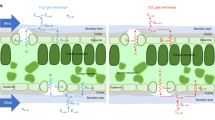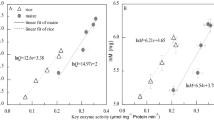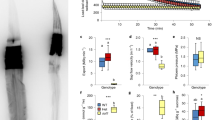Abstract
THE older writers and modern text-books affirm that the organic materials (carbohydrates, etc.) manufactured in the leaves of plants are transported downwards by means of the bast through their organs to places of consumption and storage. This belief seems to be based entirely on ringing experiments. A priori the bast appears to be very unsuitable for carrying out this function. Even in the most rapidly assimilating plants its cross-section is small. It is formed of short cells and comparatively short, narrow tubes, so that many cross-partitions must be traversed by the stream carrying these organic substances if they use it as a conduit. Furthermore, its resistance must be greatly increased by the fact that a large proportion of its cross-section is occupied by viscid contents—protoplasm and proteins. Evidently, in such a conduit we could only expect that velocities of transport comparable with diffusion velocities could be attained. Assuming that a 10 per cent, solution of sucrose were supplied by the leaves and that this was completely converted into an insoluble carbohydrate in a storage organ 50 cm. distant, then we might expect, after a steady state had been attained, a rate of transport, from diffusion alone, of about 2 milligrams per sq. cm. per diem. This would be equivalent to a 10 per cent. solution moving at the rate of 0.2 mm. per diem. Although this diffusion rate of transport might be somewhat accelerated by protoplasmic streaming, it is quite evident that diffusion in the bast is inadequate to account for the observed rate of transport of carbohydrates in plants. The insufficiency of diffusion to transport carbohydrates is strikingly borne out by those experiments in which cut floating leaves exposed to conditions suitable for photosynthesis accumulate carbohydrates, while only negligible quantities find their way into the water.
This is a preview of subscription content, access via your institution
Access options
Subscribe to this journal
Receive 51 print issues and online access
$199.00 per year
only $3.90 per issue
Buy this article
- Purchase on Springer Link
- Instant access to full article PDF
Prices may be subject to local taxes which are calculated during checkout
Similar content being viewed by others
Author information
Authors and Affiliations
Rights and permissions
About this article
Cite this article
DIXON, H., BALL, N. Transport of Organic Substances in Plants. Nature 109, 236–237 (1922). https://doi.org/10.1038/109236a0
Issue Date:
DOI: https://doi.org/10.1038/109236a0
This article is cited by
Comments
By submitting a comment you agree to abide by our Terms and Community Guidelines. If you find something abusive or that does not comply with our terms or guidelines please flag it as inappropriate.



